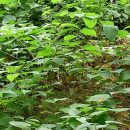
Guest Blog: Emerging Knotweed on Development Sites
A guest blog from Japanese Knotweed Ltd.
What is Japanese Knotweed?
Across the country on development sites, Japanese knotweed will be emerging from winter dormancy. One of the quirks of Japanese knotweed is the speed with which it grows in the early stages of spring. The new seasons shoots can grow 6 inches a day and ultimately produce stems as high as 3 metres.
On some sites the appearance of knotweed will come as a complete surprise to the developer, who was unaware of its presence on site. Other sites will be expecting it, and will have planned for its remediation.
Identifying Japanese knotweed early on a site allows the developer to request an assessment of the problem by a specialist, and obtain costings for dealing with it. If obtained early enough, these costings may allow negotiation on the land price.
What damage does is cause?
Japanese Knotweed is fast growing and difficult to kill and is getting out of control. It can push through concrete and tarmac and do damage to building foundations and drainage.
The root, which can grow to a depth of three metres, is considered controlled waste which must be disposed of at a licensed landfill.
Who can help?
Upon request Japanese Knotweed Ltd will attend the site to confirm the identity of the plant, assess its extent, and evaluate best methods of remediation. This is provided to the client within a Knotweed Management Plan (KMP) for the site.
The KMP will record the knotweed problem within site plans and photographs. It will include proposed development drawings (where available) and use these to evaluate feasible and recommended methods of remediation. The KMP document will then be used to record the remedial works undertaken and provide a complete record of the knotweed and its treatment.
Any works conducted to control or eradicate this invasive weed should be completed in accordance to the Knotweed Codes of Practice issued by the Environment Agency (V3, 2013) and the Property Care Association (2013). They explain measures to be taken to avoid spreading the knotweed on and off site, which may include erection of fencing at a distance of 7m from the visible extent of knotweed plant to avoid disturbance of the knotweed rhizome contaminated ground.
What treatment is needed?
Where Japanese knotweed is not going to be disturbed by development, it can be treated in situ with a Herbicide Treatment Programme. Otherwise, it needs to be excavated. Excavation methods for managing Japanese knotweed involve either removing it as controlled waste from site to an approved landfill, or, if there is a suitable location, keeping it on-site as a burial or a relocation.
There are pro’s and con’s for both methods. Landfill is relatively expensive and reduces valuable landfill capacity, however it provides the client a clean site without any residual risk of knotweed. It can also be implemented quickly and is feasible in nearly all cases. Alternatively the knotweed can be sustainably disposed of on site in a deep burial, or relocated to a more appropriate area of the site for herbicide treatment. However these on-site solutions require the future owner of the site to be aware, and to make others aware, of knotweed contamination on site, which is not always satisfactory.
As part of the excavation process the arising knotweed contaminated spoil can be sifted or screened (using a specialist equipment) to reduce the contamination or fecund material within the spoil. It is important to note that this process does not produce clean spoils free from knotweed. The sifted soils must still be treated as knotweed contaminated, and their re-use on site needs to be recorded (for monitoring). Alternatively, if it is removed from site it is classed as controlled waste.
Japanese Knotweed Ltd provides the full range of methodologies, tailored to suit the development needs of individual sites. Following receipt of an order, each project starts with a meeting on site between a member of their experienced operations team and the client’s team. This ensures that there is full understanding on both sides of what is required and what precautions need to be taken to avoid accidentally spreading the problem within the site.
Case Studies:
Full Excavation and Removal of Japanese knotweed (Dig and Dump)
For a national postal distribution company’s depot in Walsall, Midlands, Japanese Knotweed Ltd (JKL) proposed the excavation of knotweed to allow for planned development works. 430m2 of knotweed was excavated, resulting in 945 tonne of knotweed waste removed to landfill over 7 days. JKL’s expert supervised dig provided our client an approx. £150,000 saving compared to them undertaking the excavation themselves; the area cleared was 7m out from the knotweed and to a depth of 3m. A very satisfied client was provided a guarantee upon completion.
Contract value: £50,000
Excavation and on-site Cell Burial
A Polo club bought some farmland in Berkshire to use as a sports pitch, with 200m2 of knotweed upon it. Part of the development proposal was to create landscape bunds along the field periphery, which created an ideal location for burying the knotweed. A ground investigation report confirmed it was suitable for burial (no ground water and sub-strata suitable for deep excavation). 5 days on site saw the movement of a total of 3,100m3 of soils, installation of 450m2 root barrier and 150m of heat welded joins to form the burial cell. The solution avoided waste going to landfill (sustainable remediation) and a guarantee was provided on completion.
Contract value: £8,000
This guest blog was produced by Japanese Knotweed Ltd. For more information or to speak to someone from the company directly, click here.

It’s going to be ending of mine day, except before finish I am reading this great article to increase my know-how.|